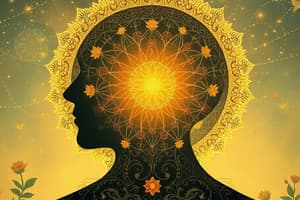Podcast
Questions and Answers
Consciousness describes our awareness of internal and external ______
Consciousness describes our awareness of internal and external ______
stimuli
Awareness of internal stimuli includes feeling pain, hunger, thirst, sleepiness, and being aware of our thoughts and ______
Awareness of internal stimuli includes feeling pain, hunger, thirst, sleepiness, and being aware of our thoughts and ______
emotions
Awareness of external stimuli includes seeing the light from the sun, feeling the warmth of a room, and hearing the voice of a ______
Awareness of external stimuli includes seeing the light from the sun, feeling the warmth of a room, and hearing the voice of a ______
friend
Sleep is a state marked by relatively low levels of physical activity and reduced sensory awareness that is distinct from periods of rest that occur during ______
Sleep is a state marked by relatively low levels of physical activity and reduced sensory awareness that is distinct from periods of rest that occur during ______
In between these extremes are states of consciousness related to daydreaming, intoxication as a result of alcohol or other drug use, meditative states, hypnotic states, and altered states of consciousness following sleep ______
In between these extremes are states of consciousness related to daydreaming, intoxication as a result of alcohol or other drug use, meditative states, hypnotic states, and altered states of consciousness following sleep ______
Often, we are not completely aware of our surroundings, even when we are fully ______
Often, we are not completely aware of our surroundings, even when we are fully ______
A woman's menstrual cycle is an example of a biological rhythm.
A woman's menstrual cycle is an example of a biological rhythm.
Body temperature fluctuates cyclically over a 24-hour period.
Body temperature fluctuates cyclically over a 24-hour period.
Alertness is associated with higher body temperatures.
Alertness is associated with higher body temperatures.
The suprachiasmatic nucleus (SCN) is the brain's clock mechanism located in the hypothalamus.
The suprachiasmatic nucleus (SCN) is the brain's clock mechanism located in the hypothalamus.
Our sleep-wake cycle is an example of a circadian rhythm.
Our sleep-wake cycle is an example of a circadian rhythm.
Flashcards are hidden until you start studying
Study Notes
Consciousness and Awareness
- Consciousness encompasses our awareness of both internal and external stimuli.
- Internal awareness includes sensations such as pain, hunger, thirst, sleepiness, and self-referential thoughts.
- External awareness involves perceiving environmental elements like sunlight, room temperature, and sounds, such as a person speaking.
States of Consciousness
- Sleep is characterized by low physical activity and diminished sensory awareness, differentiating it from periods of mere rest.
- Intermediate states of consciousness include daydreaming, intoxication from substances like alcohol, meditative practices, hypnotic states, and altered consciousness after sleep.
Biological Rhythms
- Biological rhythms, such as the menstrual cycle, illustrate natural cycles within the body.
- Body temperature experiences cyclical changes over a 24-hour period, with higher temperatures linked to higher alertness.
- The suprachiasmatic nucleus (SCN) serves as the brain's internal clock, located in the hypothalamus, regulating the sleep-wake cycle as a circadian rhythm.
Studying That Suits You
Use AI to generate personalized quizzes and flashcards to suit your learning preferences.




